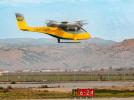Air France B772 over Atlantic on Dec 9th 2010, lithium battery fire in cabin
An Air France Boeing 777-200, registration F-GSPK performing flight AF-681 (dep Dec 8th) from Atlanta,GA (USA) to Paris Charles de Gaulle (France) with 219 passengers, was enroute at FL380 over the Atlantic Ocean near Ireland about 90 minutes prior to estimated landing in Paris when cabin crew noticed an electrical burning smell near passenger seat 4F. Cabin crew disconnected power from the inflight entertainment system, removed the seat cover from seat 4F, saw open flames and doused the fire with water. After the fire was identified positively extinguished the captain decided to continue the flight to Paris, where the aircraft landed safely.
The French BEA released their final report in French concluding the cause and learned lessons from this incident were:
fire in the cabin due to a Lithium battery, that fell into the seat mechanism. The battery was crushed causing an internal short circuit and heat that resulted in fire.
The disconnection of power from the inflight entertainment system before anything else is an effective protection against risks associated with many other seats sharing the equipment.
Cabin crew subsequently extinguished the fire by pouring water over the fire. This water extinguished the flames and cooled the battery, however, the water could have caused increased intensity of fire and could have made it much more difficult to put the fire out due to hydrogen being released by the reduction of Lithium in water.
A new procedure introduced by Air France advocating the initial use of Halogen extinguishers solves this problem but introduces the use of a gas harmful to health, the use of which could be especially dangerous in the cockpit.
In the USA the FAA uses a different procedure recommending operators to isolate electrical power, then extinguish the flames with Halon or water, then cool the unit to stop internal reactions. There is no universal procedure established to extinguish fires in cockpit or cabin.
The BEA reported that the seat in business class was electrically operated. Following the event a Lithium battery capable of delivering of 1Ah, 5V at 500mA, used in a personal electronic device by a passenger, was found entangled in the seat mechanism. The battery showed signs of fire. It is possible that the batterry slid behind the seat cover into the seat mechanism via the arm rest or the side seat.
X-ray examination of the battery showed that the battery had received internal damage probably causing a short circuit, which resulted in heat, the Lithium supplying oxygen and initiating combustion.
The FAA had released a safety alert to operators with respect to Lithium Battery Fires (see News:How to fight fires caused by Lithium batteries in portable electronic devices) recommending the use of Halon or Water to extinguish the fire and in any case Water to cool the battery. However, European Agencies did not issue a similiar recommendation.
The BEA mentioned a similiar case happened on the very same aircraft on May 2nd 2013 on a flight from Paris to Sao Paulo, when just short of the top of descent a mobile phone caught fire after sliding under a seat cushion. The crew used Halon to extinguish the fire and subsequently had the phone under a flow of cold water until after landing.
http://avherald.com/h?article=47057db2














Komentarze